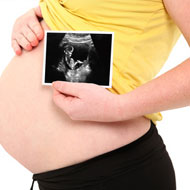All You Need To Know About Ovulation Symptoms
Whether you wish to have a baby or want to avoid getting pregnant, it is important to know the process and symptoms of ovulation. The reproductive process is the result of an intricate balance of hormones and corresponding changes to different parts and functions of a woman's body. It all begins with a menstrual cycle.
During the first half of the cycle, the body readies itself for possible conception. Hormones cause the walls of the uterus to thicken and the ovaries to release a mature egg into either of the fallopian tubes.
This process of ovulation occurs around day 14 of a typical 28-day menstrual cycle. If the released egg is not fertilized with a male sperm, the ovum disintegrates within 12 to 24 hours. Since a healthy sperm can survive for up to 48 hours inside the body, women are most fertile two days before and after ovulation.
Most ovulation symptoms occur before and during the process of ovulation - when the mature egg is released from the ovaries. Just remember that all these ovulation symptoms are not the same for every woman and can vary in terms of intensity as well. The various symptoms of ovulation include:
- Cervical mucus changes - One of the most common symptoms of ovulation is an increase in the amount of vaginal discharge. While this increase may vary from case to case, most women report a significant difference in the discharge that includes a change in its consistency. In order to facilitate the movement of the sperm into the uterus, the cervical mucus changes and becomes thicker and more elastic but remains clear or creamy-white in color.Changes in cervical position - As the time of ovulation approaches, the position of the cervix begins to change. At its most fertile point, the cervix is higher, softer and more open than normal to encourage the passage of the sperm and the process of fertilization.
- Spike in libido - When women hit the fertile peak in their menstrual cycle at the time of ovulation, many may experience an increase in their sexual drive. This increase in libido is attributed to changes in hormone levels when ovulation takes place and is nature's way of ensuring sexual intercourse and reproduction.
- Basal Body Temperature - The basal body temperature is one of the most popular ways of predicting ovulation. If a woman keeps a track of her basal body temperature over a period of a few months, she will notice a slight drop in temperature just before ovulation. Once the egg has been released, this temperature spikes sharply and continues to rise if conception takes place. Keep in mind though that erratic sleep schedules can affect readings of basal body temperature making this method of predicting ovulation not as reliable as hoped.
- Mittelschmerz or Middle Pain - Some women complain of abdominal pain or discomfort during ovulation. The pain is usually a mild cramping on one side of the lower abdomen and happens when the egg is released from a follicle and travels down one fallopian tube. In some cases, ovulation pain could be accompanied by light spotting or bleeding.
- Sore breasts - As progesterone levels increase, breasts become sore and tender to the touch. Size of the breasts may increase marginally and so does sensitivity.
Breast soreness is also an early sign of pregnancy so it is common to be confused and read too much into this symptom. - Heightened senses - There are cases where women complain of a change to their sense of smell or taste just prior to ovulation. A sudden dislike of certain foods or smells or sensitivity to noises can affect a small amount of women but is not a common symptom of ovulation.
- Night sweats and hot flashes - Much like the symptoms of menopause, some women may experience night sweats and hot flashes during ovulation. High progesterone levels during the end of the ovulation cycle can cause these changes.
- Headaches - Women who suffer from frequent headaches or are prone to migraines may complain of an increase in headache symptoms around the time of ovulation. If there is no history of headaches or migraines, this is not a common occurrence.
- Nausea and dizziness - These are not common signs of ovulation and may be a sign of an ovarian cyst. If a woman consistently complains of dizziness or nausea during ovulation, it can indicate an underlying medical condition that requires immediate attention.
Once a woman is aware of the different symptoms of ovulation, she can pay closer attention to her body and keep track of ovulation or maintain an ovulation calendar to either avoid or encourage a pregnancy. In addition to being aware of the signs of ovulation, a woman can test for ovulation with the help of an ovulation predictor kit. These kits measure the changes in hormones in the urine and can accurately pinpoint the approach of ovulation. Many experts consider ovulation predictor kits more reliable than monitoring basal body temperature changes. However, these kits can be expensive and do not offer a hundred percent guarantee of fertility and conception.
Medical tests such as blood tests and pregnancy ultrasounds can also check whether or not ovulation has taken place. Blood tests check the level of progesterone and should be taken between three to ten days before the next expected period. A progesterone level of 20nmol/L determines that ovulation has taken place. A pregnancy ultrasound is the best way of confirming the presence of a fetus and that ovulation and conception has taken place.


